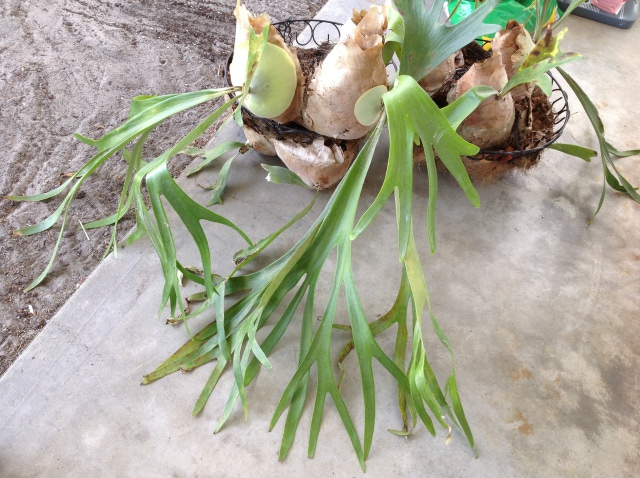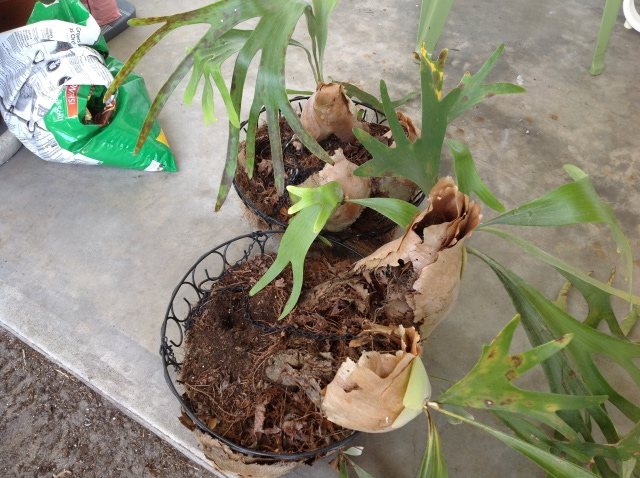Question Staghorn 2
Staghorn 2
 Staghorn 1
Staghorn 1
QUESTION: Hi. About a week ago i acquired 2 staghorns that were my husbands grandfathers, so their like cherished family heirlooms. I know at one point it was a single fern but i believe it fell and broke in two. They seem very unhealthy to me the antler like fronds have yellow and brown spots and the tips of them look to be dying and curling. Their in hanging baskets but i have know idea what they were potted in or how they've been cared for. These are my first staghorns so any help identifying the problems and solutions is greatly appreciated.
ANSWER: Lynn hi;
Thanks for the awesome question and pictures. There is no greater pleasure than helping people with plants to which they ascribe emotional value.
To me, these plants appear to have outlived the usefulness of their containers. They have also definitely been through physical trauma (falling and breaking apart).
If you are in the center - south part of the state, you would be best advised to 'mount' the individual plants on a board under the oak tree (more on that, further down my answer).
If you are north of Orlando, though, you would probably be better served by planting in a basket, so you could move them indoors for frost protection.
For mounting, there a plenty of references (just google 'mounting staghorn') but my favorite instructional video was made by colleagues of mine and can be found here:
http://www.youtube.com/watch?v=g0Uy4he9vjE
For a basket, you can use the existing wire frame, fill it with fresh wet sphagnum moss, and replant the existing shield with some of the root ball behind it. From the plants you have, you can easily make 6-7 new baskets.
For long term care, staghorns are very easy and pretty much care-free. They need to be outside, under an oak or other shade tree. Most people hang them or mount right to the tree (without damaging the tree). As long as they get rain once a week or stray sprinkler mist, they will need no additional water. They can be fed twice a year with any slow-release fertilizer (found at your local garden center) but many people prefer to feed them half a banana twice a year (peel and all). Usually, they will derive ample nutrition from insect and plant debris that get caught within the crown fronds.
I would also look under the fronds (leaves) for white fuzzy spots. These are insects called scale that can be easily wiped off with some mild dish solution.
As they say, in a nutshell, thats pretty much it. You may also choose to do nothing and see what happens, but I do not like the way the plants currently look and cannot see much room for improvment in the current circumstance.
I will be happy to provide further, detailed information on re-potting or mounting if needed.
Thanks again;
DC
---------- FOLLOW-UP ----------
QUESTION: Hi. Thanks so much for your help, its very much appreciated. I was really worried they had a bacteria infection or fungus,its really nice to know u don't think thats the case. I do have another question, should i take off the damaged and discolored fronds when i remount them , or leave them alone? Thanks again :)
AnswerFrom my vantage point (and without use of a microscope and lab analysis), I do not see any indication of a debilitating vascular infection.
Sure, there are sporadic localized fungal infections but none appear lethal or threatening.
In light of this, I would recommend to leave all fronds intact when remounting.
Should a frond become useless (say more than 60% damage, yellow or brown), then I'd say remove it.
We want the plant to utilize 100% of its photosynthetic capacity (through green tissues) while it is recovering and regrowing.
DC







